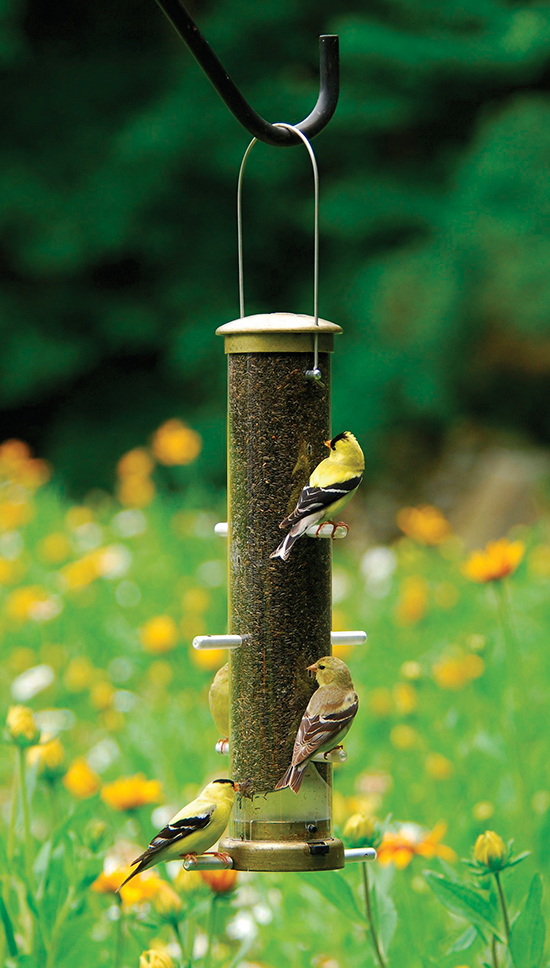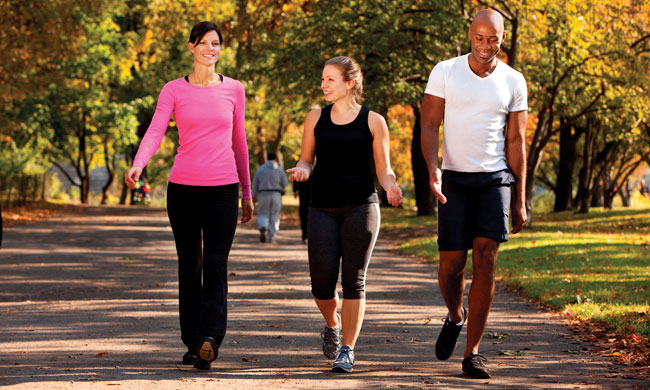HEALTHY LIVING
Attract more birds to your backyard

Basic tips for feeding wild birds
(Family Features) With all the constraints people lived through in 2020, many turned to their own backyards – nature, in particular – for hope, solace, wonder and even entertainment. Despite the worldwide crisis, nature’s normalcy remained intact; flowers continued to bloom, bees continued to pollinate and birds continued to fly and forage food.
Feeding birds can be enjoyable for any age group and provide stress relief for all who partake. A University of Exeter study, focused on nature’s impact on humans in suburban and urban areas, found lower levels of depression, anxiety and stress were associated with the number of birds people saw during afternoons at home. The benefits of birdwatching come from seeing lots of birds – quantity not “quality” – the study found.
People “felt relaxed and connected to nature when they watched birds in their gardens,” researchers said. These feelings increased with the level of bird feeding in the yard. For millions working and schooling from home, this stress reduction was an unintended bonus.
Data from 2020 shows sales of bird feed, feeders, nesting boxes and bird houses spiked as interest in backyard birds soared while people spent more time at home.
Interest in birding isn’t slowing down. If you haven’t tried attracting birds to your backyard, now is a perfect opportunity to start. The experts at Cole’s Wild Bird Products Co. offer these bird feed and feeder basics to attract more birds to your backyard.

Feeders
A variety of bird feeder types placed at different heights attract more birds than one feeder featuring one seed type. Start with two feeder types that accommodate most feed options. Bowl feeders serve not only seeds but also dried mealworms, fruit and suet. An option like Cole’s Bountiful Bowl Feeder comes with an adjustable dome cover you can raise or lower to prevent larger birds and squirrels from getting to food and protect it from rain.
Traditional tube feeders are all-purpose options for bird feeding, especially for small birds that cling. For example, the Terrific Tube Feeder is made with state-of-the-art materials to prevent warping and discoloration and includes a quick-clean, removable base to make cleaning fast and easy. Just push a button and the bottom of the feeder pops off for easy access to the inside. Rinse the feeder with soapy water, dunk it into a water-bleach solution at a concentration of 9-to-1, rinse, dry and reattach the bottom. Regular cleaning of feeders is essential for preventing mold, germs and disease.
Popular Foods
Birdseed: Not all birdseed is created equal. Look for quality blends without cheap filler like red millet and oats. All-natural seed containing no chemicals or mineral oil is safe and more appealing to birds. Top seed picks include all-natural black oil sunflower and Cole’s “Hot Meats” (sunflower meats infused with habanero chili peppers that birds love and squirrels dislike). Or an option like Special Feeder blend, packed with favorites including black oil sunflower, sunflower meats and pecans, attracts the greatest number of wild birds. Offering a wide variety, Cole’s feed is researched and specifically formulated to attract certain bird species, the largest number of birds and the greatest variety of birds.
Insects and Worms: A healthy, lush lawn is one of the best ways to feed birds that prefer insects and worms. You can supplement birds’ diets by serving dried mealworms in a packaged variety that’s easier to feed and less messy than live mealworms. Mealworms are packed with energy and contain essential nutrients, fat and protein.
Fresh Fruit: Apples, orange halves and bananas are favored fruits.
Suet: Perfect for insect-eating birds, suet is a high-fat food that provides abundant calories, rich nutrition and is a high-energy treat.
Using the right feeders and high-quality feed can enhance your backyard and entice more birds, bringing stress relief and enjoyment. For more information on attracting birds to your backyard, visit coleswildbird.com.
SOURCE:
Cole’s Wild Bird
HEALTHY LIVING
Breathe better with asthma, wherever you are

(Family Features) If you have asthma, you know that symptoms can come on quickly, then worsen.
The things that make them do that are called triggers. An important part of managing asthma is knowing your triggers at home, work, school or while you’re outdoors.
A health care provider can help you figure that out, then you can take steps to avoid those triggers and breathe easier.
At Home
Because asthma is usually due to allergies, triggers are often allergens, or things that cause allergic reactions. Allergens such as pet dander, dust mites, pests and smoke can make asthma symptoms worse in some people, and for others, even trigger an asthma attack.
The National Heart, Lung, and Blood Institute (NHLBI) suggests that it may be helpful to combine a few different strategies to help reduce exposure to triggers.
People sensitive to dust can clean with a high-efficiency particulate air (HEPA) filtration vacuum and use mattress and pillow covers that prevent exposure to dust mites. If you’re sensitive to pests like cockroaches and rodents, consider integrated pest management, which involves removing and controlling pests through methods such as traps or poison. Avoiding tobacco smoke, including secondhand smoke, can be especially helpful for some people with asthma.
At School
Asthma is one of the leading reasons children miss school. At school, kids may be exposed to dust mites, pests and mold, which may be asthma triggers for some children.
Because children spend lots of time at school, it can be helpful for teachers, school nurses or coaches to know what to do if your child’s symptoms flare up. Team up with a health care provider to develop an asthma action plan and share it with trusted adults at your child’s school.
At Work
The workplace can have hundreds of potential triggers, like chlorine-based cleaning products, bleaches, hair dyes and metal dust. Repeated exposures in the workplace can also lead to new triggers. Report new or worsening symptoms that occur at work to your health care provider and your workplace supervisor.
Outdoors
Everyday weather like cold, dry air can set off breathing problems. Air pollution can affect asthma, too.
It may be helpful to avoid some of the worst pollution by adjusting when and where you exercise. Try to avoid exercising near busy roads or industrial areas. Visit airnow.gov to check your local air quality so you can plan to avoid outdoor activities when pollution is highest.
Managing your triggers is just one part of keeping your asthma under control. Work with a health care provider to develop an asthma treatment plan that includes taking medicines as prescribed and keeping track of your symptoms and where you are when they occur. That way, you can know what’s making your asthma worse or better.
To learn more about asthma, visit NHLBI’s Learn More Breathe Better® program at nhlbi.nih.gov/BreatheBetter.
Photo courtesy of Shutterstock
HEALTHY LIVING
Walk your way to better health

(Family Features) A walk is not just good for your body, it’s also good for your soul. Physical activity, like walking, is one of the best ways to reduce stress and boost your mood. However, reports show walking rates are declining steadily in the United States.
On average, 1 out of every 4 U.S. adults sits for longer than eight hours each day, per research from the Centers of Disease Control and Prevention, which can have negative consequences on physical and mental health. Regular exercise improves mood, boosts energy and can even help you sleep better. Staying active is one of the best ways to keep your mind and body healthy.
Consider this advice from the American Heart Association, which has worked for decades to promote policies and strategies that make it easier for communities to get and stay active. One example is National Walking Day on April 3, established by the organization to encourage people to move more throughout the day so they can feel, think, sleep and live better.
Indeed, adding more movement can benefit your body and mind in numerous ways, such as:
Lowering disease risk. Getting the recommended amount of physical activity (at least 150 minutes of moderate, 75 minutes of vigorous or a combination of those activities per week) is linked to lower risk of diseases, stronger bones and muscles, improved mental health and cognitive function and lower risk of depression, according to the U.S Department of Health and Human Services.
Increasing sunlight exposure. Outdoor exercise is an easy way to get moving and take in the sunlight, which can improve mood, boost immunity and help you get some vitamin D. Spending time outdoors is a no-cost option and has been shown to reduce stress, promote a sense of belonging and improve mood.
Improving cognitive and mental function. Physical activity keeps your mind sharp now and later. Studies show higher fitness levels are linked to better attention, learning, working memory and problem solving. What’s more, a study published in the “British Journal of Sports Medicine” shows people who get the recommended amount of physical activity are less likely to develop depression.
Living longer. Healthy life expectancy can be positively impacted by increasing activity. According to research published in the “American Journal of Epidemiology,” swapping just 30 minutes of sitting with low-intensity physical activity reduced risk of death by 17%.
Get moving to reduce your stress and step into better health. Learn more at heart.org/movemore.
Get Inspired to Get Moving
A little creativity can go a long way to make your walk more fun. You might think of walking as a solo activity, but a companion makes it even more enjoyable. Ask colleagues, friends or family to join you.
A walk is a perfect excuse to take a break from a long day at your desk. If you work remotely, take a conference call on the go or plan your walk as a reward for completing a project.
Use your walk as a guilt-free opportunity to listen to a new audiobook or create a walking soundtrack of your favorite upbeat music.
Mix up your scenery. Taking new routes keeps your walks interesting and helps prevent boredom from traveling the same predictable path.
If you need an extra nudge to get moving, a pet may help you get fit. Dog parents are more likely to reach their fitness goals than those without canine companions. In fact, according to the “Journal of Physical Activity & Health,” dog parents are 34% more likely to fit in 150 minutes of walking a week than non-dog owners. Pets can also help lower stress, blood pressure, cholesterol and blood sugar and boost your overall happiness and well-being.
Photos courtesy of Shutterstock
SOURCE:
American Heart Association
HEALTHY LIVING
A genetic connection to kidney disease

How APOL1-mediated kidney disease can impact you, your kidneys and your family
(Family Features) A genetic condition that can cause kidney failure, APOL1-mediated kidney disease (AMKD) represents a group of kidney diseases associated with mutations (changes or variants) in the apolipoprotein L1 (APOL1) genes.
Typically, the APOL1 genes – of which every person has two, one from each parent – create proteins that play a role in immunity. However, some people are born with mutations in one or both genes, and having mutations in both can increase the risk of developing kidney disease and even kidney failure.
In honor of National AMKD Awareness Day on April 30, consider this information from the experts at the American Kidney Fund to better understand the disease and become APOL1 aware.
Understanding Risk Factors
Research shows Black people with kidney disease are more likely to develop kidney failure than any other racial or ethnic group. The reasons for these health disparities include social determinants of health, a higher burden of diabetes and high blood pressure in the Black community, barriers to health care access and genetics.
The APOL1 gene mutations evolved over the past 3,000-10,000 years in people who lived in western and central Africa and are associated with increased protection from a parasite carried by the tse tse fly that causes African sleeping sickness. While protecting from one disease, the mutation – if inherited in both APOL1 genes – is more likely to lead to kidney disease in those of certain African descent, including people who identify as Black, African American, Afro-Caribbean or Latina or Latino.
In fact, an estimated 13% of Black Americans have two APOL1 gene mutations, according to the American Kidney Fund. While not everyone who has two APOL1 mutations will get kidney disease, there is a 1 in 5 chance they will go on to develop AMKD.
Identifying Symptoms
If you have kidney damage, symptoms may not occur until your kidneys are close to failing. As kidney damage worsens, one or more of these symptoms may occur:
- Protein in urine
- Swelling in legs or weight gain
- Feeling weak or tired
- High blood pressure
Should these symptoms occur and you have a family history of kidney disease, talk to a doctor about getting tested for kidney disease, as testing is the only way to determine kidney function. AMKD can cause damage to parts of the kidney that filter blood or, in some cases, cause cells in the kidneys to die, which can lead to damage and scarring that may eventually lead to kidney failure.
Getting a Diagnosis
The only way to know if you have APOL1 gene mutations is to do genetic testing via a blood or saliva sample. Genetic testing may be considered if you have kidney disease and don’t know the cause or if you’re considering donating a kidney. Testing may also be considered if a family member is a carrier for the mutation. If you have questions about genetic testing, discuss your options with a doctor or ask for a referral to a genetic counselor.
Taking Steps to Prevent Kidney Disease
There are currently no treatments available for AMKD. However, there are steps you can take to protect your kidneys and promote general health. Work with your doctor to create a plan to prevent or delay the progression of kidney disease, which may include:
- Doctor visits to check how your kidneys are working through urine and blood tests
- Checking for and managing diabetes and high blood pressure
- A healthy eating plan, which may involve limiting things like sodium (salt)
- Taking prescription medications as directed
- Being active at least 30 minutes each day of the week
- Quitting smoking or using tobacco
If you have the APOL1 gene mutations, you may be able to take part in clinical trials. Trials could provide an opportunity for researchers to develop and test safe treatments for AMKD. Also speak with family members about having genetic testing done if you have the mutation as they may also have it.
Learn more and find additional resources at kidneyfund.org/APOL1aware.
Photo courtesy of Shutterstock
SOURCE:
American Kidney Fund
-

 NEWS1 year ago
NEWS1 year ago2 hurt, 1 jailed after shooting incident north of Nocona
-

 NEWS6 months ago
NEWS6 months agoSuspect indicted, jailed in Tia Hutson murder
-

 NEWS1 year ago
NEWS1 year agoSO investigating possible murder/suicide
-

 NEWS1 year ago
NEWS1 year agoWreck takes the life of BHS teen, 16
-

 NEWS10 months ago
NEWS10 months agoMurder unsolved – 1 year later Tia Hutson’s family angry, frustrated with no arrest
-

 NEWS1 year ago
NEWS1 year agoSheriff’s office called out to infant’s death
-

 NEWS1 year ago
NEWS1 year agoBowie Police face three-hour standoff after possible domestic fight
-

 NEWS1 year ago
NEWS1 year agoDriver stopped by a man running into the street, robbed at knifepoint





